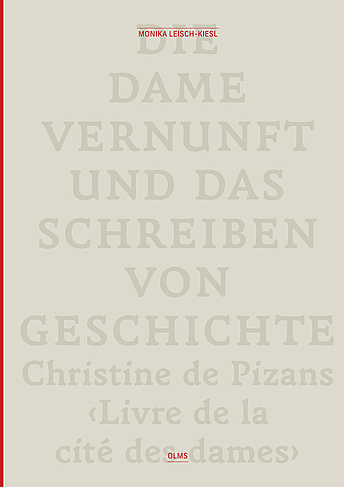Leisch-Kiesl
Die Dame Vernunft und das Schreiben von Geschichte / Lady Reason and the Writing of History
ISBN 978-3-487-16021-4
englischLe livre de la cité des dames (The Book of the City of Women) by the French writer and philosopher Christine de Pizan (1364-ca. 1430) is one of the most widely read writings of the early 15th century and is considered one of the first feminist works of European literature. As the fruit of the immense reading activity of a highly educated author, it reflects the intellectual and socio-political debates of its time and also testifies in its book aesthetics that Christine de Pizan was intent on disseminating her word and image compositions in a multi-layered as well as self-confident form. The multidisciplinary examination of the widely ramified research field of "Christine de Pizan" continues unabated to this day. The art historian and philosopher Monika Leisch-Kiesl, well versed in historical gender research and an expert in the field of book illumination, now succeeds in a convincing way in taking the viewer-reader into the often surprising world of thought of a young woman writer at the French court at the beginning of the Renaissance. In doing so, she not least emphasises the utopian potential of the poetess active in early 15th century Paris, which is still effective today. Moreover, Sibylle Ryser's extraordinary and congenial book design sets a jewel of medieval book art - in an edition that is also bilingual - in an illuminating dialogue with its scholarly analysis. VOICES ON THE BOOK "Monika Leisch-Kiesl manages to cast scholarly writing in a style that is also addressed to a target group outside the relevant readership (...) Image and text result in an overall composition in the publication itself. In this sense, Monika Leisch-Kiesl's transdisciplinary work can be recommended to all those interested in history, art history, philosophy, theology and feminist gender studies. The book has a few more surprises in store and will certainly cause many an astonishment in the faces of the readers. (Raphaela Hemetsberger, ThPQ 170/2022)
Le livre de la cité des dames (Das Buch von der Stadt der Frauen) der französischen Schriftstellerin und Philosophin Christine de Pizan (1364–ca. 1430) zählt zu den meist gelesenen Schriften des frühen 15. Jahrhunderts und gilt als eines der ersten feministischen Werke der europäischen Literatur. Als Frucht der immensen Lektüretätigkeit einer hochgebildeten Autorin reflektiert es die intellektuellen und gesellschaftspolitischen Debatten seiner Zeit und bezeugt auch in seiner Buchästhetik, dass Christine de Pizan darauf bedacht war, ihre Wort- und Bild-Kompositionen in vielschichtiger wie selbstbewusster Form zu verbreiten. Die multidisziplinäre Auseinandersetzung mit dem weitverzweigten Forschungsfeld „Christine de Pizan“ dauert bis heute ungebrochen an. Der Kunstwissenschaftlerin und Philosophin Monika Leisch-Kiesl, bewandert in historischer Genderforschung und Expertin auf dem Gebiet der Buchmalerei, gelingt es nun auf überzeugende Weise, den/die Betrachter-Leser/in mitzunehmen in die vielfach überraschende Gedankenwelt einer jungen Schriftstellerin am französischen Hof zu Beginn der Renaissance. Dabei betont sie nicht zuletzt das auch heute noch wirksame utopische Potential der im Paris des frühen 15. Jahrhunderts tätigen Poetin. Die außergewöhnliche und kongeniale Buchgestaltung Sibylle Rysers setzt überdies ein Juwel mittelalterlicher Buchkunst – in einer zudem zweisprachigen Ausgabe – in einen erhellenden Dialog mit dessen wissenschaftlicher Analyse. STIMMEN ZUM BUCH "Monika Leisch-Kiesl schafft es, wissenschaftliches Schreiben in einen Stil zu gießen, der auch an eine Zielgruppe außerhalb der einschlägigen Leserschaft gerichtet ist (…) Bild und Text ergeben in der Publikation selbst eine Gesamtkomposition. In diesem Sinne kann das transdisziplinäre Werk von Monika Leisch-Kiesl allen Interessent:innen der Geschichte, Kunstgeschichte, Philosophie, Theologie und feministischen Genderforschung empfohlen werden. Das Buch hält noch so einige weitere Überraschungen bereit und wird sicherlich so manches Erstaunen in den Gesichtern der Leser:innen hervorrufen." (Raphaela Hemetsberger, ThPQ 170/2022)


